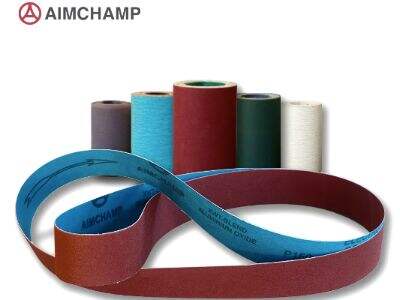One of the earliest methods used to smooth rough stones was rubbing them together. It was a very difficult task and also it consumed much time. We are lucky today because WE HAVE SANDPAPER! Sandpaper from Aimchamp is another paper with small pieces of sand glue8 to its surface. Sand: These are pieces of sand, which in gaming terms help smooth surfaces out. Sandpaper comes in many forms, and different types are well-suited for various tasks. This guide will introduce the different kinds of sand papers, what they are capable of and give you some tips on using them.

Understanding Sandpaper Grits
Sand paper Grits and Sanding Disc is available with various "grits. Grit is a word that describes the coarseness of sandpaper Important is the number grit The higher they are, the smoother the sand paper handler. The lower numbers meaning the sandpaper is very rough. Now that you know how to prepare your surface, we need to determine rougher areas of resistance require lighter grit sand paper. A rule of thumb is if it takes a tonne lot effort for the paint or filler to scuff onto, then go ahead and use around 80—grit receptacle throughout example! This coarser sandpaper is useful for elimination of ridges and rough areas that stick out. However, if you have some really smoothed out surfaces that just need a light scrubbing down, then use sandpaper with extra grit. This will help make the surface very soft feeling.
Use of Sandpaper with Backing vs Without
Occasionally, a sandpaper and Scouring Pad will come with something called backing. A backing is a type of raw tape that holds the sandpaper together process. It is mostly of paper and cloth. Backing: Backing is important because it helps to make the sandpaper last longer and easier to hold. When sanding a flat surface like a table or board, it is recommended to use backed sand paper. This allows you to hold the piece better and it helps keep your sandpaper flat. But if you are sanding a curved part, like the leg of chair for instance, maybe it would be better with only paper. This type of sandpaper is saner and curves on the sanded area better.
Unique Projects Require Special Sandpapers
At times, you will encounter surfaces that resist the sanding and Sanding Sponge. And that is where the unique sand papers come in! There are sand papers that can be made specific to the material, such as metal and plastic even drywall of wall use. These are the same as above in functionality but they could be used for a special project like working on an old piece of furniture or making something new. Type of Sandpaper is Reasonable ImportantUsing the right kind/the wrong type, and you can actually damage your work surface. Always spend some time reflecting on what you require, prior to your initial diceful preparation.
Sanding with the Further Coarse Grits
You use the rough sandpaper, but it should be done right. If you don't, chances are good that you will scratch the laptop up and/or mark up whatever surface it is resting on. The first thing that you should do is a little bit of sanding with the grain of your wood. You want to work back and forth WITH THE GRAIN hence directionally sand down the wood. This can help you in getting the best results. If you have the roughest grit sandpaper, start with that one and gradually work your way down through all of them. You do not want to press too hard, as pressing too pressure can hurt the top. As you are working through your grit cycle, the rougher sand papers require less pressure but as you get down to finer papers it allows a little more heavy-handedness (technical woodworking terminology LOL) and gives some leeway when changing your direction of movement. The key is to sand with the grain of the wood, but always finish in that direction.
Using Sandpaper Safely!
Sandpaper is great, provided it's used in a safe manner. Opt for safety goggles and a mask whenever you are sanding. Those will shelter your eyes and lungs from the dangerous of dust. Sanding dust can make your eyes water and cause coughing. It is also important that sandpaper not be handled with your hands because they will leave a greasy residue. These small grains of sand can enter the skin and lead to irritation or abrasions. Finally, always sand in a ventilated area (had no good word lol,) meaning an open place so you can easily inhale dust.

 EN
EN
 AR
AR BG
BG HR
HR CS
CS DA
DA NL
NL FI
FI FR
FR DE
DE EL
EL HI
HI IT
IT JA
JA KO
KO NO
NO PL
PL PT
PT RO
RO RU
RU ES
ES SV
SV TL
TL IW
IW ID
ID SR
SR ET
ET MT
MT TH
TH TR
TR FA
FA AF
AF MS
MS GA
GA CY
CY MK
MK EU
EU KA
KA LA
LA NE
NE